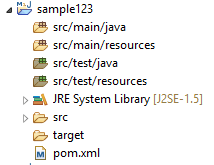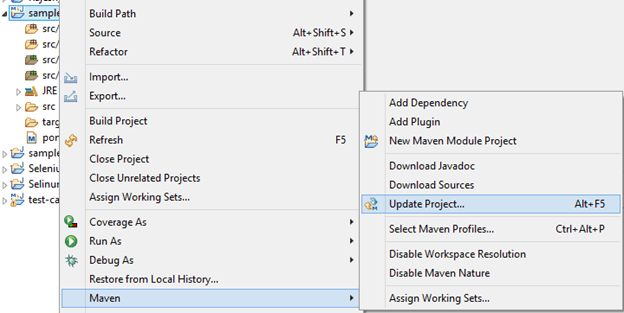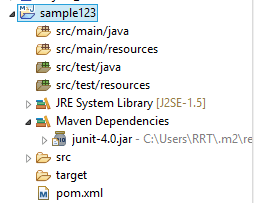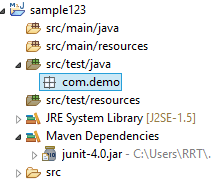Updated February 21, 2023
Introduction to JUnit 4 Maven
JUnit is an open-source testing framework used to test java projects built in maven projects. Normally JUnit 4 is used to perform regression testing on an application. In other words, we can say that here we can write the test script and run it in the repeatable test as per our requirement. Unit testing is white box testing in which experiments depend on inward construction. The analyzer picks contributions to investigate specific ways and decides the relevant result. The reason for unit testing is to look at the distinct parts or bits of techniques/classes to confirm usefulness, guaranteeing the conduct is true to form.
What is JUnit 4 maven?
JUnit is a Java unit testing structure that is one of the unique test techniques for relapse testing. An open-source structure is utilized to compose and run repeatable mechanized tests.
Similarly, as with whatever else, the JUnit 4 testing system has advanced over the long haul. The significant change to note is the presentation of explanations that showed up with the arrival of JUnit 4, which gave an increment in association and lucidness of JUnits. Therefore, the remainder of this blog entry will be composed of utilizations of Junit 4 and 5.
The specified content of Junit 4 is independent of Junit 5 and an independent assignment (for example, a solitary strategy or class). There is a valid justification that we limit scope while unit testing – assuming we develop a test that includes various parts of a venture, we have moved concentration from the usefulness of a solitary technique to cooperation between various bits of the code. Assuming the test fizzles, we don’t have the foggiest idea why it fizzled, and we are left contemplating whether the weak spot was inside the strategy we were keen on or in the conditions related to that technique.
Supplementing unit testing relapse testing verifies that the most recent fix, improvement, or fix didn’t break existing usefulness by testing the progress you made to your code. Code changes are unavoidable, regardless of whether they are adjustments to existing code or adding bundles for new usefulness… your code will unquestionably change. In this change, it is the most risk, so in light of that, relapse testing is an unquestionable requirement.
How to Install JUnit 4 maven?
Now let’s see how we can install JUnit 4 as follows.
First, we need to create the maven project in eclipse, so inside the file, the menu selects new then other project and provides the group id and artifact id per our requirement. After creating a project, it looks like as shown in the following screenshot.
Now we need to make some changes inside the pom.xml file, which means we need to add the dependency of JUnit as follows.
<!-- https://mvnrepository.com/artifact/junit/junit -->
<dependency>
<groupId>junit</groupId>
<artifactId>junit</artifactId>
<version>4.0</version>
<scope>test</scope>
</dependency>Now save the pom.xml file, right-click on the project name, click on maven, and inside the maven, select the Update Project option as shown in the following screenshot.
After updating the project, we can see the file structure shown in the following screenshot.
Creating JUnit 4 maven
Now let’s see how we can create JUnit 4 maven with examples.
We have already created the maven project; let’s add a package inside the main, as shown in the following screenshot.
Now create the class and write code; here, we see a simple example of a simple program.
Just create a class file like a sample demo and paste the following code.
package com.demo;
import static org.junit.Assert.assertTrue;
import org.junit.After;
import org.junit.AfterClass;
import org.junit.Before;
import org.junit.BeforeClass;
import org.junit.Test;
public class sampledemo {
@BeforeClass
public static void beforeClassmethod() {
System.out.println("Hi welcome in Before Class Method");
}
@Before
public void beforemethod() {
System.out.println("Hello there welcome in Before Test Case strategy ");
}
@Test
public void Test() {
System.out.println("Welcome in First Test");
}
@After
public void aftermethod() {
System.out.println("Hi welcome in After Test Case");
}
@AfterClass
public static void afterClassmethod() {
System.out.println("Hi welcome in After Class");
}
}Explanation
In the above example, we try to cover JUnit annotation as shown in the above code. We illustrated the final output of the above implementation using the following screenshot.
JUnit 4 maven method
Now let’s see different types of methods as follows.
@Test: It is used to determine that this is a test method.
@Before: This method is executed before each test case as per our requirement.
@After: This method is used to execute the after each test case as per our requirement. In other words, we can say that it is executed after each test. It cleans up the test climate (e.g., erase impermanent information, reestablish defaults). It can likewise save memory by tidying up costly memory structures.
@BeforeClass: Executed once, before the beginning, everything being equal. It is utilized to perform time escalated exercises, for instance, to interface with a data set. Techniques set apart with this comment should be characterized as static to work with JUnit 4.
@AfterClass: Executed once, after all tests have been done. It is utilized to perform tidy-up exercises, for instance, to separate from an information base. Strategies clarified with this explanation should be static to work with JUnit 4.
@Ignore: Marks that the test should be crippled. This is helpful when the actual code has been changed and the experiment has not yet been adjusted. Or on the other hand, on the off chance that the execution season of this test is too lengthy to be in any way included. It is best practice to give a discretionary depiction of why the test is incapacitated.
Conclusion
We hope from this article you learn more about the JUnit 4 maven. From the above article, we have taken in the essential idea of the JUnit 4 maven, and we also see the representation and example of the JUnit 4 maven. Furthermore, this article taught us how and when to use the JUnit 4 maven.
Recommended Articles
This is a guide to JUnit 4 Maven. Here we discuss the essential idea of the JUnit 4 maven, and we also see the representation and example. You may also look at the following articles to learn more –








